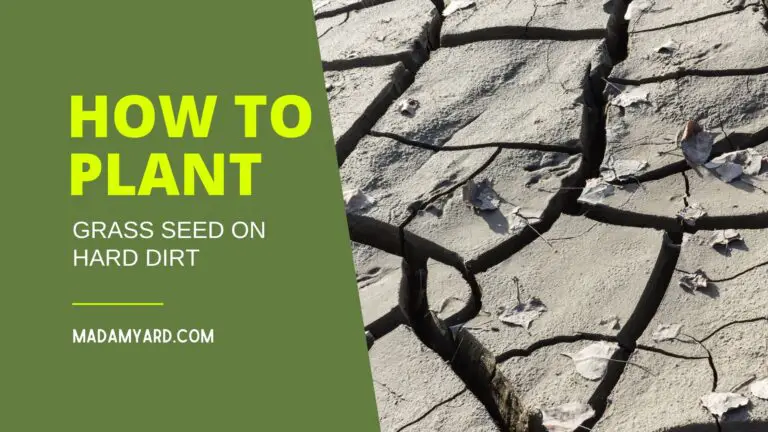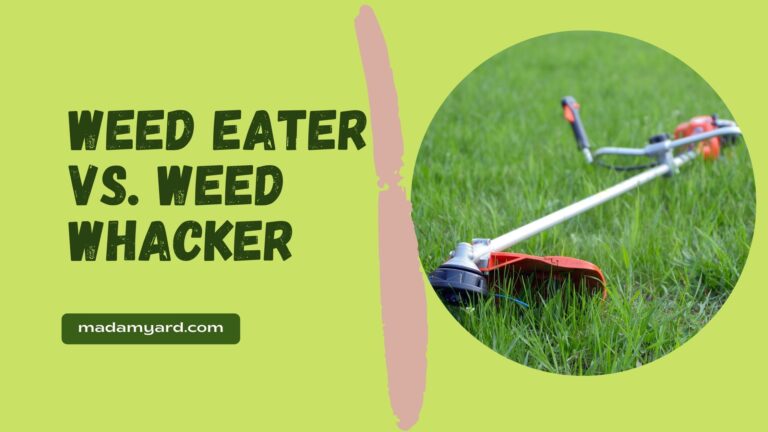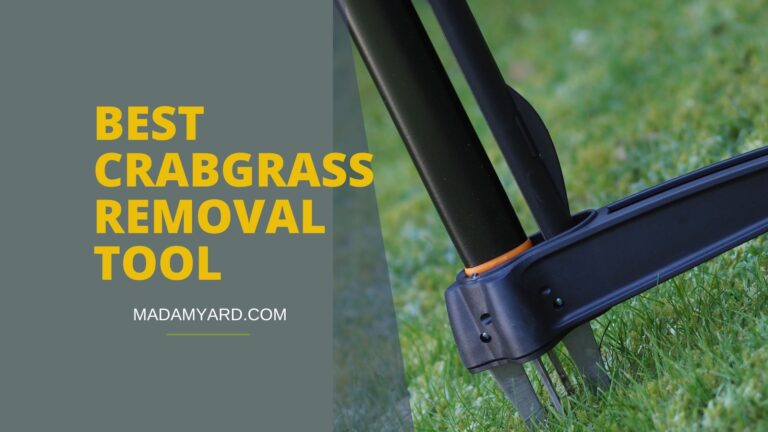How To Cover Up Mud In Backyard?
When it rains, does your yard turn into a muddy mess? Muddy spots are a typical problem in backyards, as irritating as they are. When people go by, a muddy stretch is an eyesore and a severe hazard. So, how to cover up mud in the backyard?
A lovely yard needs a lot of upkeep. Your yard is likely to become muddy if you live in a region that receives a lot of rain throughout the year. You’ll need to get your hands filthy now and again if you want that green piece of land to look its finest.
Many individuals are puzzled as to how to deal with a muddy yard. It’s nice to stay in and listen to the rainfall on the windows, but the notion of your yard in the morning may keep you up for a long time.
It doesn’t matter what caused the yard to get muddy; you must remedy the situation. It may be an issue with your drainage pipes, or it could be a pair of hyperactive dogs running about in your yard.
Regardless matter the problem, drying and fixing muddy yards is critical. Whatever the cause, I’ll show you how to cover mud in your lawn with some simple techniques.
Why Is All This Mud In My Backyard?
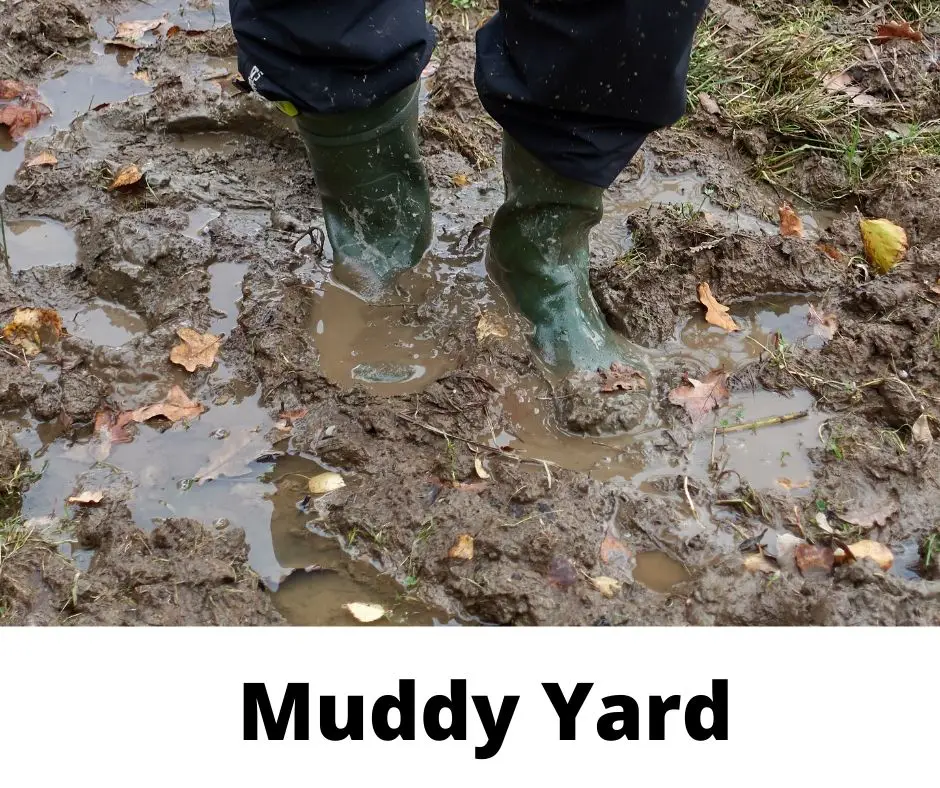
There are many options for dealing with mud and transforming your muddy yard into a lovely environment. However, it’s critical to understand why water accumulates in your garden in the first place.
Identifying the source of the water buildup can assist you in making a more informed selection about the remedy you should employ in your garden. You may also save money by not purchasing lawn coverings that do not prevent muck from accumulating.
Three common causes of water buildup in your lawn that lawn covers may not solve:
1. Drainage Problems
Some houses construct with drainage pipes that go to the grass. The positioning of these pipes is deliberate in the aim of using rainfall to irrigate the lawn.
Too much rain, combined with flat lawns devoid of plants or trees to absorb the water, on the other hand, will result in water stagnation on the soil. As a result, a muddy area develops.
If you have this issue, you should first address your drainage unless you design the area and convert it into a beautiful garden.
2. Low Terrain
Some homes aren’t blessed with a perfectly flat lawn. As a result, much of the precipitation collects on the land’s lowest topography, forming puddles that eventually turn to mud.
In this situation, constructing a gazebo or meditation space is a more feasible choice. You may also level the lawn, but this will take more time and may require the use of a backhoe to make digging simpler.
3. Weather
If you live in an area with more rain than sunlight throughout the year, you will undoubtedly have a muddy lawn.
Any grass cover would be a waste in this situation, and choices such as installing a porch would be the wisest course of action.
How To Cover Up Mud In Backyard?
The easiest method to solve this problem is to level out your yard so that water does not collect in one area and produce muck.
You may even use a tractor or a rake to clean up your property. It depends on the size of your backyard, the amount of muck, and the amount of effort you want to put into it.
However, you may want the cheapest way to cover dirt in the backyard.
Therefore, here are the best ways to cover mud.
1. Use Creeper Plants To Cover The Mud
Creeping plants usually referred to as “creepers,” are fast-growing ground-covering plants.
They have delicate stems and sensitive stems. If the muddy area of your lawn receives little foot activity, this is the best solution.
Creeper plants, like the ones we see in Disney movies, may hide dirt in your lawn. Some of these creeper plants bloom on the ground, creating a fantasy garden in your backyard.
These plants are a low-cost choice, and you may even be able to obtain them for free from a kind neighbor or acquaintance.
Creeping Thyme, Mini Kenilworth, Candytuft, Blue Star Creeper, Clover, Silver Carpet, Irish Moss, and Winter Creeper are some best creepers for ground coverings.
2. Fix A Patchy Lawn By Overseeding
If the problem is due to the patchy grass, overseeding your lawn is a highly efficient way to deal with muddy patches in your yard.
Overseeding will most likely address your mushy lawn problems if you have bald areas in your lawn where grass doesn’t grow. Overseeding entails preparing the soil, sowing grass seed and water regularly.
It is an excellent method to use if you want to repair dog tracks left by your canines racing through your yard while it’s raining and muddy.
You’ll have to keep them away from the area for a time to avoid disturbing the seed, but once it establishes, it’ll be a long-term answer.
3. Lay Gravel To Cover Mud
It’s one of the most straightforward methods to enhance drainage and avoid a muddy yard. You can avoid water from collecting in your grass and provide a significant amount of space for your children to play in the yard with just a little gardening.
Poor drainage is the primary cause of a yard becoming muddy and blocked, as we’ve seen in this article. The water in the yard does not drain correctly, causing the soil to become muddy.
You should construct a landscape fabric, such as a walkway, for the grass that links two different areas of the property. The usage of lawn gravel is the best idea since it allows for improved drainage.
Furthermore, the earth will be considerably spongier, allowing for improved drainage.
Gravel is very simple to place on lawns and offers consumers a long-term solution. Gravel is by far the finest choice if you want to fix your wet yard concerns.
So that wet spots do not form, the gravel should be put in strategic locations around the property.
It’s recommended to consult a gardener if you’re unsure where to put gravel in your yard. They could offer you a better sense of where the gravel should be placed on your land.
4. Spread Wood Chips Or Mulch
Wood chips for the muddy yard are temporary ground cover. Wood mulch is typically favored over other fast ground covers because of its organic content, look, and durability.
Unlike straw, mulch for the muddy yard may last up to a year on the grass before needing to be replaced. Mulch is a more appealing ground covering than gravel and is popular in flower gardens.
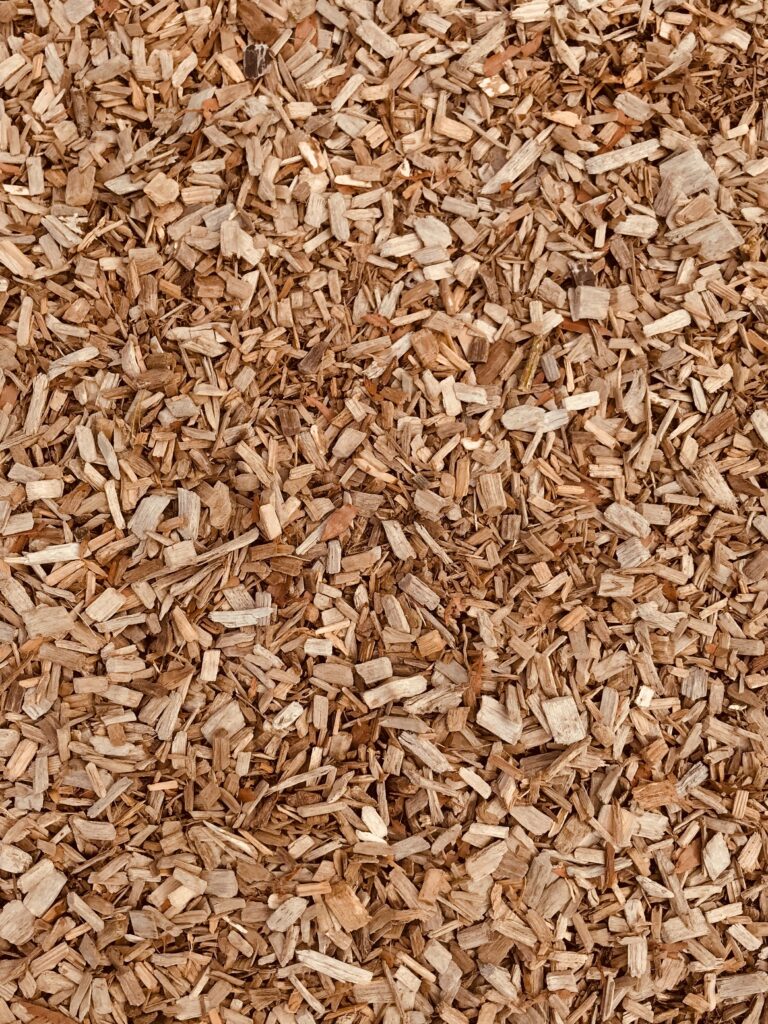
Although mulch is more expensive than chips, landscaping retailers may give discounts on large purchases.
There are numerous varieties of mulch to choose from, so comparing costs might save yard owners money.
Wood chips are good insulators for the soil and can absorb some moisture. If you want to plant something in a muddy location, this is also the best method to nurture it.
If you have mulch on hand, you may combine that with the wood chips. It is a cost-effective and natural approach to coping with a muddy backyard.
Wood chips that have been pre-treated with pesticides, on the other hand, should never be used since they can poison the soil and destroy adjacent plants.
Cypress and pine cedar are two surefire alternatives for covering the ground for individuals new to wood mulching. It will also keep weeds at bay if you keep the covering 4 inches thick.
Also, avoid mulching at the base of existing plants, as the roots will adhere to the compost and cause it to decay quickly.
5. Build A Pathway To Cover Mud
If a portion of your grass is already bare, it’s the perfect spot for a new pathway. It may be used as a walking route or simply for decoration.
Foot traffic is a common cause of bare muddy spots on the lawn or in the yard. Walking routes hide bare areas and prevent the emergence of new ones. When you build a route, you’ll be able to walk without causing a mess.
A walking route can design in a variety of ways. A walkway might be made of concrete, stepping stones, concrete pavers, mulch, gravel, or anything else you can think of.
If you’re using pavers or concrete tiles, you’ll need to level them with a layer of sand below. It is also safer to walk on a path after it rained since there is a better grip.
After that, sprinkle sand between the crevices to prevent weeds from sprouting. Sand also aids drainage between concrete pavers on your property.
6. Create A Patio
Building a patio is an excellent solution, particularly if you have mud right outside your door.

You’ll start by smoothing off the area and putting a layer of sand and crushed rock, much as with ground cover ideas. It will not only help absorb any excess water but will also provide a solid, level surface for your pavers to be laid on.
After that, you may place your pavers and then cover them with sand, sweeping them into all of the joints with a broom.
7. Build A Rain Garden
Learning to work in a damp environment is frequently the most practical approach to coping with a muddy lawn in a rainy area. If a section of your lawn is too damp to sustain grass, create a rain garden with water-tolerant plants.
You may also utilize your rain garden to divert water from your downspouts into a safe location. Please make sure the location you pick is at least 10 feet away from your foundation, regardless of how you utilize it.
Make three zones in your rain garden: a moist zone at the bottom, a middle zone, and a transition zone at the lawn’s border. Then, based on their water tolerance, pick plant species for each zone.
Many plants, such as elderberry (Sambucus), swamp rose (Rosa Palustris), blue vervain (Verbena Hastata), and goldenrod (Solidago), can survive up to 6 inches of standing water for short periods, making them ideal wet zone options.
8. Cover The Mud With Concrete
Pouring concrete into the muddy area would be the best choice if you want a long-term solution. However, before pouring the concrete, you must prepare the area with an edge framework and underlay.
Also, I advocate doing this on dry days because rain will inevitably wash the concrete away, causing a significant mess in your yard.
The only issue with concrete is that it may just move the water to another location in your yard. It is why I advocate using this approach in conjunction with appropriate ground leveling and drainage. In that manner, the problem is solved.
9. Lay Down Some Sod
Sod can help your grass absorb excess rainwater and enhance the soil’s condition. One of the quickest and most suggested methods for removing muck and transforming your yard into a natural-looking green.
It’s important to remember that you’ll need to prepare the mud ahead of time if you want to use this approach to keep it for a more extended period.
If you choose a low-cost option, the sod will cost you 8 cents per square foot or more, while choosing quality will boost your budget even more.
As a result, it is not very cheap. Because laying sod on a huge muddy spot may devastate your finances. However, if money isn’t an issue, it may be a fantastic option.
10. Improve The Drainage
Poor drainage is frequently the root cause of a muddy lawn. Examine the water exiting your downspouts the next time it rains.
If your yard is ruined by rain runoff, make sure the drains reach at least 6 feet past your foundation. Direct the downspouts to a ditch, pond, or other low-lying location outside the lawn if feasible. To handle the runoff, make sure these drainage zones are clean of plants and debris.
Another probable source of mud buildup is the slope of your grass. Water will accumulate on a lawn that is level or slightly lower in the middle.
To fix this, re-grade your lawn so it slopes away from your house at a rate of at least 2%, or 1/4 inch every foot. Rainwater is encouraged to flow off the grass as a result of this.
Taking topsoil from the bottom side of the lawn and transferring it to the higher side is the easiest approach to re-grade your grass.
Install A Drainage Pipe
Simply diverting water to the perimeter of your property may be the most efficient technique of improving drainage. You’ll either need to rent an excavator or a shovel, some elbow grease, and a lot of patience to do this.
Dig a trench in a downward manner, starting just uphill from your muddy location. As you’ll need to lay a four-inch drainage pipe inside, the trench should be at least six inches broad.
It should also be approximately a foot deep. However, you’ll need to slant it downhill to maintain a downward slope, so if you’re cutting over a rise, you’ll need to dig deeper.
After that, you’ll require a perforated pipe. The uphill end is closed, while the downhill end is open. Then, fill the entire trench with fresh grass and plant it on top.
Loosen Up Your Soil
Drainage issues are due to compacted soil that has gotten too thick to absorb water effectively. It not only results in muck, but it can also prevent roots from penetrating the soil.
In this instance, as more of your grass or ground cover dies off, the problem will worsen over time.
Using an aeration tool to poke holes into the surface of the grass is the best remedy for muddy yards. Aeration helps water to drain through compacted topsoil, which is the most common source of water retention in a lawn that is otherwise well-graded.
You may hire a commercial-grade power aerator for large lawns or rent a manual aerator for smaller lawns. Even a metal rod with a sharp end can be stabbed into the earth.
Whatever method you choose, not only will this enhance water drainage, but it will also improve the general health of your grass by loosening up affected soil and encouraging root development.
Dethatch Your Yard
Thatch is a term used to describe tiny patches of grass that emerge from the lawn soil. Although the grass generally dies, it stays on top of the soil. Now, a little thatch is OK, and it benefits the soil since it contains broken organic materials.
However, suppose your grass develops an excessive quantity of thatch. In that case, it may act as a barrier between water and air, resulting in a dump yard. The turf will begin to deteriorate as well.
Dethatching is an essential gardening technique that involves removing all of the thatch from your lawn. It is generally accomplished with the use of a mechanical device.
This isn’t as difficult or time-consuming as mowing the grass, but it is something you should consider.
It could be the best idea to dethatch your garden if you detect a lot of thatch. A simple rake or a dethatching mower can be used to remove the dead stuff.
Apart from that, it would be best if you thought about aerating the lawn and fertilizing it. If you see wet spots in your yard and the topsoil has a spongy feel, you should realize that it’s most likely due to too much thatch.
Conclusion
So, what’s the most effective technique to cover mud in the backyard?
It all relies on the source of the problem. As a result, your initial step should be to pinpoint the cause of the issue.
It is simple by determining whether you have a fixable drainage problem. Drainage is usually is the cause of your grass being just wet in one spot or on a slope.
On the other hand, all of the adjacent lawns are likewise wet. Drainage won’t help much. The water can’t flow anywhere since there’s nowhere for it to go! You’ll need to either utilize the water, soak it up, or cover it up in that case.
Whatever option you choose, we hope we were able to lead you ideally. All that’s left to do now is go outdoors and start landscaping!



